Utilization of Bio-Mineral Carbonation for Enhancing CO2 Sequestration and Mechanical Properties in Cementitious Materials
Abstract
:1. Introduction
2. Experiment Procedures
2.1. Characterization of Bio-Mediated Ureolysis and CO2 Hydration Metabolism
2.2. Specimen Preparation and Characrization Test
3. Results and Discussions
3.1. Evaluation of Ureolysis and CO2 Hydration Performances
3.2. Changes in the Microstructure and Mechanical Properties by Bacterial Mineral Carbonation
3.3. Phase Identification and Quantitative Analysis of Hydrates of Paste Specimens
4. Conclusions
- (1)
- The bacterial mineral carbonation metabolism proceeds by bacterial inherent enzyme-based catalytic reactions, and the metabolism activity by enzymes is closely related to the growth rate. In the exponential growth phase, the largest amounts of urease and carbonic anhydrase are produced, which resulted in rapid metabolic activity.
- (2)
- The compressive strength value of carbonation-cured specimens was higher than that of water-cured specimens. This is attributed to the promotion of the hydration of stable C2S under carbonation conditions, and a large amount of CaCO3 in a stable state is produced by decalcification of hydrates.
- (3)
- The mineral carbonation based on ureolysis and the CO2 hydration process can produce carbonate minerals from urea and CO2, respectively. The carbonate minerals reduced the pore size and porosity by filling the pores of cementitious materials, thereby improving the mechanical properties.
- (4)
- In the carbonation-cured specimens without bacteria, the hydrates (i.e., Ca(OH)2, C–S–H gel) were decalcified by inflow of CO2, which lowered the pH due to a decrease in Ca(OH)2 in the pore solution. In addition, in the carbonation-cured specimens incorporating bacteria forming carbonic anhydrase, a significant decrease of pH and high carbonation degree value were observed. It is postulated that the carbonation process can be accelerated by incorporation of the bacterial paste solution, due to relatively more CO2 uptake by hydration retardation and the bacterial mineral carbonation metabolism.
Author Contributions
Funding
Data Availability Statement
Conflicts of Interest
References
- Yadav, R.; Labhsetwar, N.; Kotwal, S.; Rayalu, S. Single enzyme nanoparticle for biomimetic CO2 sequestration. J. Nanopart. Res. J. 2011, 13, 263–271. [Google Scholar] [CrossRef]
- Liu, M.; Hong, S.; Wang, Y.; Zhang, J.; Hou, D.; Dong, B. Compositions and microstructures of hardened cement paste with carbonation curing and further water curing. Constr. Build. Mater. 2021, 267, 121724. [Google Scholar] [CrossRef]
- Ravikumar, D.; Zhang, D.; Keoleian, G.; Miller, S.; Sick, V.; Li, V. Carbon dioxide utilization in concrete curing or mixing might not produce a net climate benefit. Nat. Commun. 2021, 12, 855. [Google Scholar] [CrossRef]
- Liu, Z.; Meng, W. Fundamental understanding of carbonation curing and durability of carbonation-cured cement-based composites: A review. J. CO2 Util. 2021, 44, 101428. [Google Scholar] [CrossRef]
- Chen, T.; Bai, M.; Gao, X. Carbonation curing of cement mortars incorporating carbonated fly ash for performance improvement and CO2 sequestration. J. CO2 Util. 2021, 51, 101633. [Google Scholar] [CrossRef]
- Kaddah, F.; Ranaivomanana, H.; Amiri, O.; Rozière, E. Accelerated carbonation of recycled concrete aggregates: Investigation on the microstructure and transport properties at cement paste and mortar scales. J. CO2 Util. 2022, 57, 101885. [Google Scholar] [CrossRef]
- Kaur, G.; Dhami, N.K.; Goyal, S.; Mukherjee, A.; Reddy, M.S. Utilization of carbon dioxide as an alternative to urea in biocementation. Constr. Build. Mater. 2016, 123, 527–533. [Google Scholar] [CrossRef]
- Talakokula, V.; Bhalla, S.; Ball, R.J.; Bowen, C.R.; Pesce, G.L.; Kurchania, R.; Bhattacharjee, B.; Gupta, A.; Paine, K. Diagnosis of carbonation induced corrosion initiation and progression in reinforced concrete structures using piezo-impedance transducers. Sens. Actuators A Phys. 2016, 242, 79–91. [Google Scholar] [CrossRef] [Green Version]
- Zajac, M.; Lechevallier, A.; Durdzinski, P.; Bullerjahn, F.; Skibsted, J.; Ben Haha, M. CO2 mineralisation of Portland cement: Towards understanding the mechanisms of enforced carbonation. J. CO2 Util. 2020, 38, 398–415. [Google Scholar] [CrossRef]
- Yahui, Y.; Gang, X.; Bin, T. Carbonation characteristics of cement-based materials under the uniform distribution of pore water. Constr. Build. Mater. 2021, 275, 121450. [Google Scholar] [CrossRef]
- Nodehi, M.; Ozbakkaloglu, T.; Gholampour, A. A systematic review of bacteria-based self-healing concrete: Biomineralization, mechanical, and durability properties. J. Build. Eng. 2022, 49, 104038. [Google Scholar] [CrossRef]
- Knorre, H.v.; Krumbein, W.E. Bacterial calcification. In Microbial Sediments; Springer: Berlin/Heidelberg, Germany, 2000; pp. 25–31. [Google Scholar]
- Bose, H.; Satyanarayana, T. Microbial carbonic anhydrases in biomimetic carbon sequestration for mitigating global warming: Prospects and perspectives. Front. Microbiol. 2017, 8, 1615. [Google Scholar] [CrossRef]
- Bhagat, C.; Dudhagara, P.; Tank, S. Trends, application and future prospectives of microbial carbonic anhydrase mediated carbonation process for CCUS. J. Appl. Microbiol. 2018, 124, 316–335. [Google Scholar] [CrossRef] [Green Version]
- Qian, C.; Chen, H.; Ren, L.; Luo, M. Self-healing of early age cracks in cement-based materials by mineralization of carbonic anhydrase microorganism. Front. Microbiol. 2015, 6, 1225. [Google Scholar] [CrossRef] [Green Version]
- Kim, H.; Son, H.; Park, S.; Lee, H.-K. Effects of biological admixtures on hydration and mechanical properties of Portland cement paste. Constr. Build. Mater. 2020, 235, 117461. [Google Scholar] [CrossRef]
- Auroy, M.; Poyet, S.; Le Bescop, P.; Torrenti, J.-M.; Charpentier, T.; Moskura, M.; Bourbon, X. Comparison between natural and accelerated carbonation (3% CO2): Impact on mineralogy, microstructure, water retention and cracking. Cem. Concr. Res. 2018, 109, 64–80. [Google Scholar] [CrossRef]
- Seo, J.; Kim, S.; Park, S.; Yoon, H.N.; Lee, H.K. Carbonation of calcium sulfoaluminate cement blended with blast furnace slag. Cem. Concr. Compos. 2021, 118, 103918. [Google Scholar] [CrossRef]
- ASTM C109/C109M-20; Standard Test Method for Compressive Strength of Hydraulic Cement Mortars (Using 2-in. or [50-mm] Cube Specimens). ASTM: West Conshohocken, PA, USA, 2016.
- Snellings, R.; Chwast, J.; Cizer, Ö.; De Belie, N.; Dhandapani, Y.; Durdzinski, P.; Elsen, J.; Haufe, J.; Hooton, D.; Patapy, C. RILEM TC-238 SCM recommendation on hydration stoppage by solvent exchange for the study of hydrate assemblages. Mater. Struct. 2018, 51, 172. [Google Scholar] [CrossRef]
- Son, H.M.; Kim, H.Y.; Park, S.M.; Lee, H.K. Ureolytic/Non-Ureolytic Bacteria Co-Cultured Self-Healing Agent for Cementitious Materials Crack Repair. Materials 2018, 11, 782. [Google Scholar] [CrossRef] [Green Version]
- Sharma, T.; Kumar, A. Efficient reduction of CO2 using a novel carbonic anhydrase producing Corynebacterium flavescens. Environ. Eng. Res. 2020, 26, 200191. [Google Scholar] [CrossRef]
- Bundur, Z.B.; Kirisits, M.J.; Ferron, R.D. Biomineralized cement-based materials: Impact of inoculating vegetative bacterial cells on hydration and strength. Cem. Concr. Res. 2015, 67, 237–245. [Google Scholar] [CrossRef]
- Jang, J.G.; Kim, G.M.; Kim, H.J.; Lee, H.K. Review on recent advances in CO2 utilization and sequestration technologies in cement-based materials. Constr. Build. Mater. 2016, 127, 762–773. [Google Scholar] [CrossRef]
- Jang, J.G.; Lee, H.K. Microstructural densification and CO2 uptake promoted by the carbonation curing of belite-rich Portland cement. Cem. Concr. Res. 2016, 82, 50–57. [Google Scholar] [CrossRef]
- Van den Heede, P.; De Schepper, M.; De Belie, N. Accelerated and natural carbonation of concrete with high volumes of fly ash: Chemical, mineralogical and microstructural effects. R. Soc. Open Sci. 2019, 6, 181665. [Google Scholar] [CrossRef] [Green Version]
- Seo, J.H.; Amr, I.T.; Park, S.M.; Bamagain, R.A.; Fadhel, B.A.; Kim, G.M.; Hunaidy, A.S.; Lee, H.K. CO2 Uptake of Carbonation-Cured Cement Blended with Ground Volcanic Ash. Materials 2018, 11, 2187. [Google Scholar] [CrossRef] [Green Version]
- Ochs, M.; Mallants, D.; Wang, L. Radionuclide and Metal Sorption on Cement and Concrete; Springer: Berlin/Heidelberg, Germany, 2016; Volume 2. [Google Scholar]
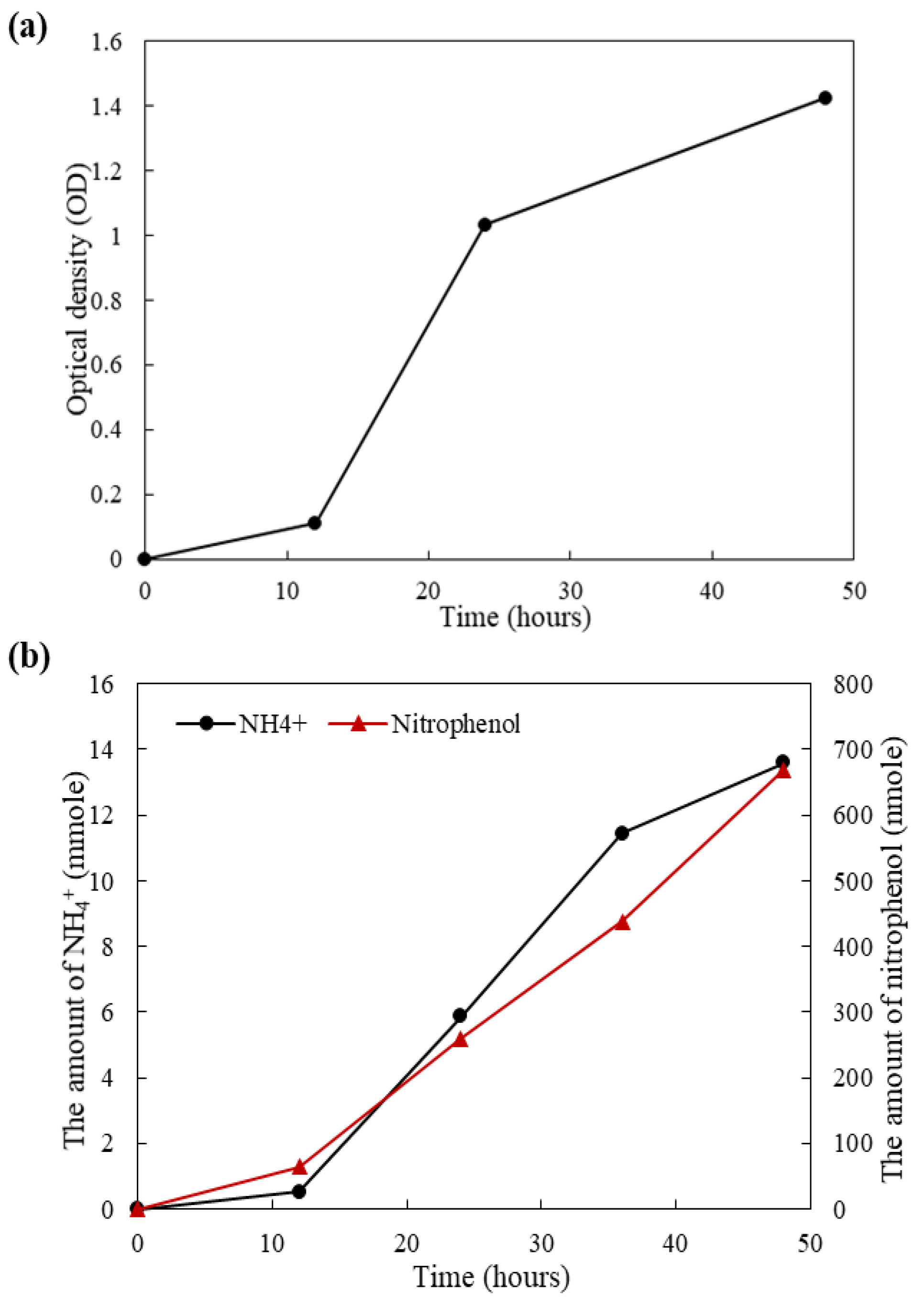
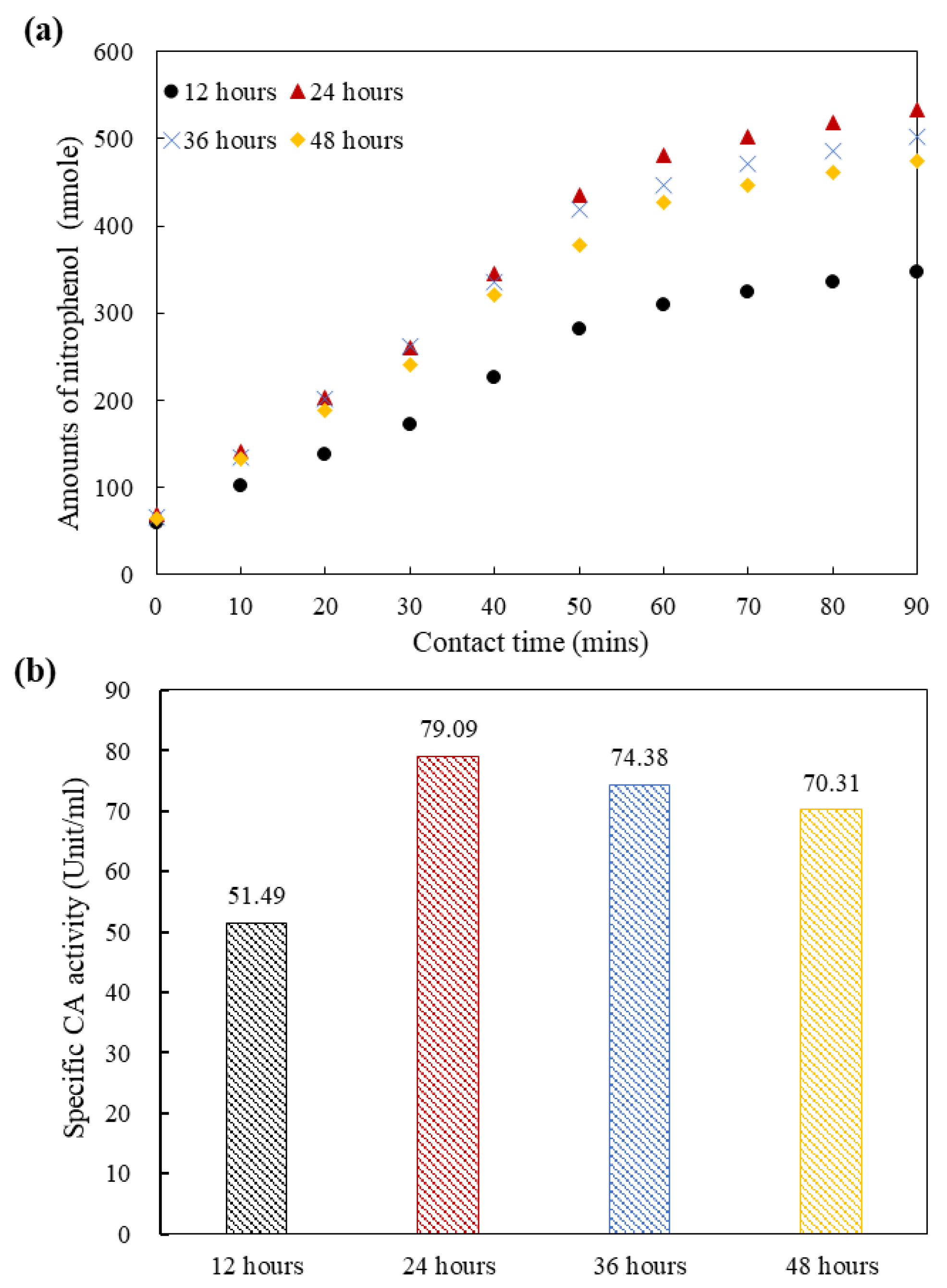
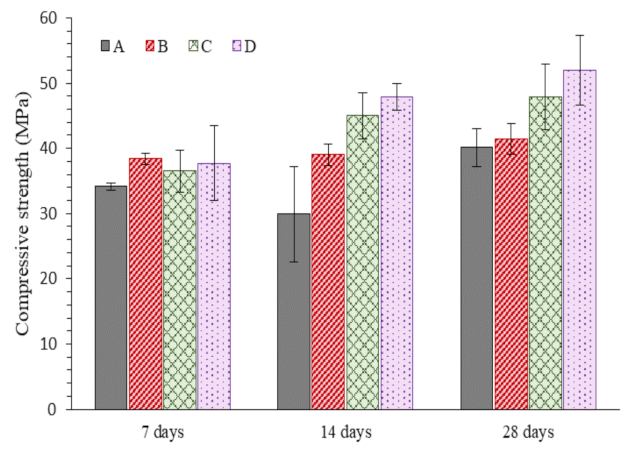
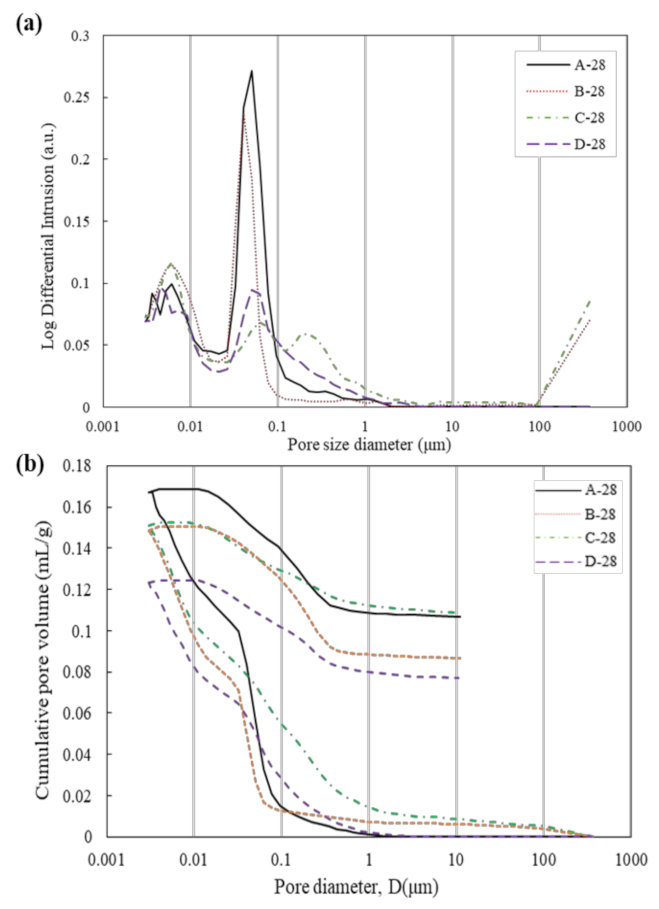
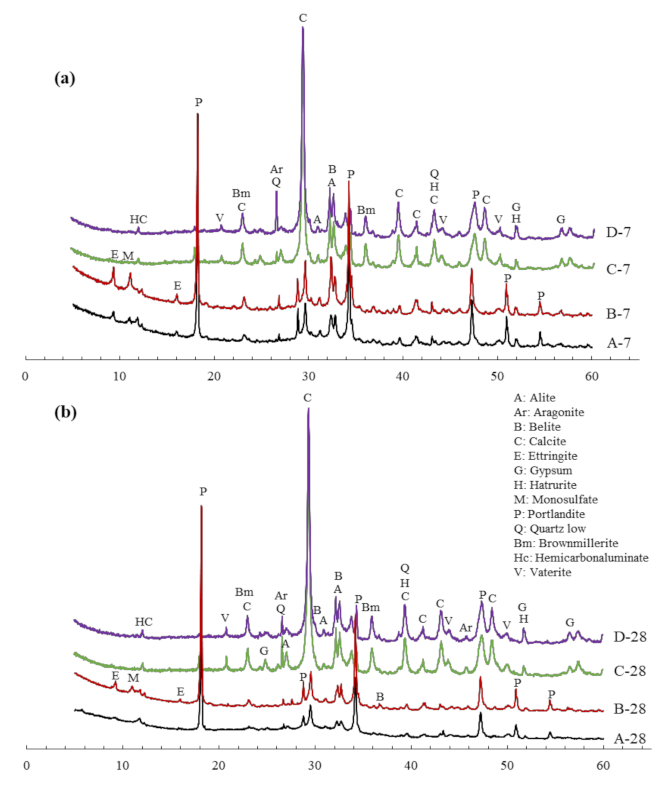
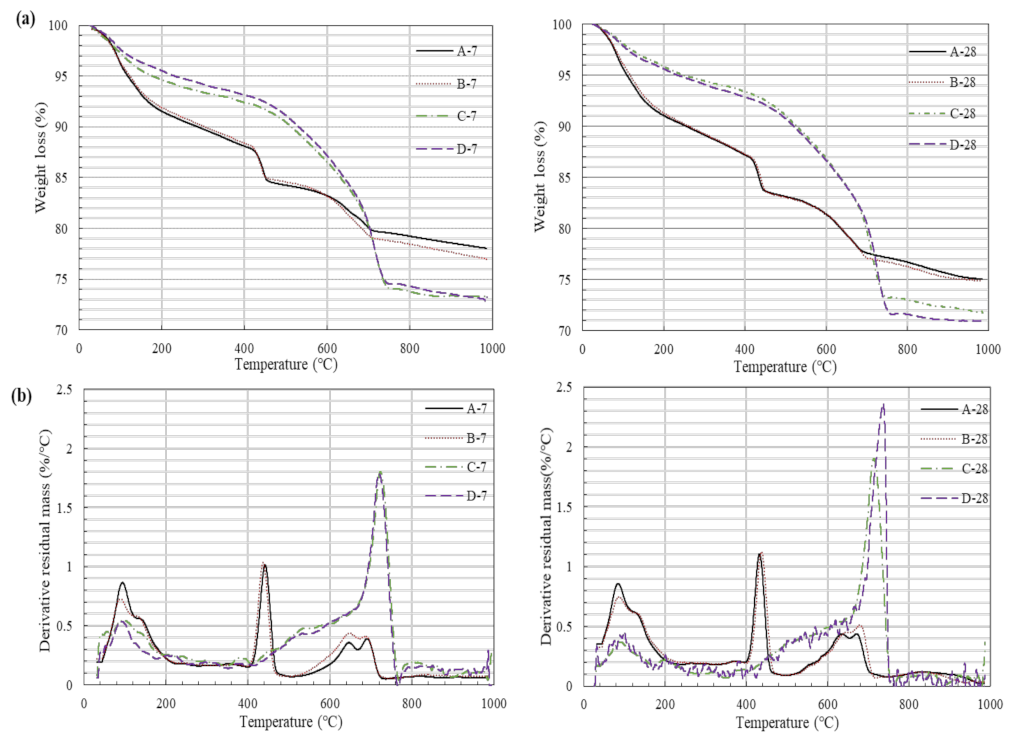
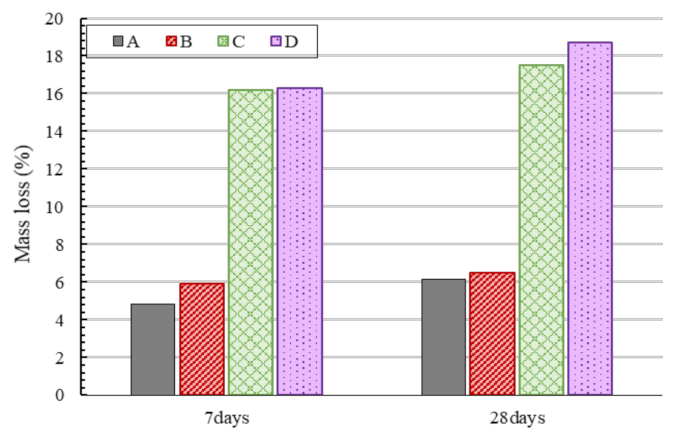
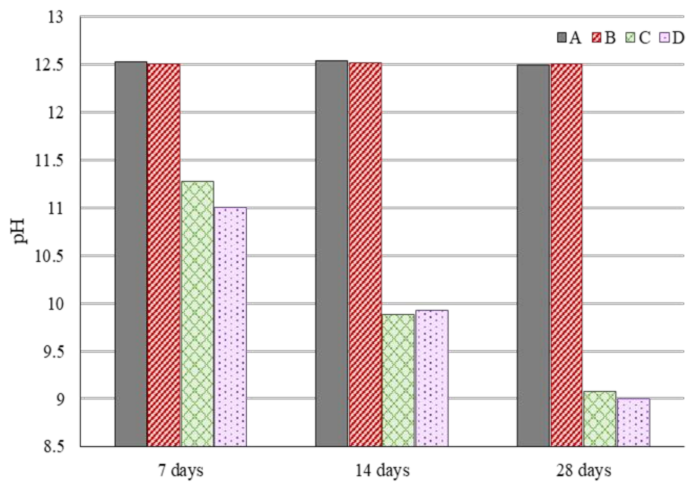
| Specimen ID | Cement | Water | Ureolysis Solution * | CO2 Sequestration Solution ** | AE Agent *** | Curing Condition |
|---|---|---|---|---|---|---|
| A | 1 | 0.4 | 0.001 | Water curing | ||
| B | 1 | 0.4 | 0.001 | |||
| C | 1 | 0.4 | 0.001 | Carbonation curing | ||
| D | 1 | 0.4 | 0.001 |
| Specimen ID | Porosity | Average Pore Diameter | Median Pore Diameter (Area) * |
|---|---|---|---|
| A | 27.54% | 14.50 nm | 5.86 nm |
| B | 28.51% | 11.83 nm | 5.78 nm |
| C | 26.20% | 13.78 nm | 5.44 nm |
| D | 22.03% | 12.58 nm | 5.22 nm |
| Time | Specimen C | Specimen D | |
|---|---|---|---|
| Carbonation degree (%) | 7 days | 15.36% | 44% |
| 14 days | 22.56% | 59.04% | |
| 28 days | 44% | 72.96% | |
| 18.05 | 43.32 |
Publisher’s Note: MDPI stays neutral with regard to jurisdictional claims in published maps and institutional affiliations. |
© 2022 by the authors. Licensee MDPI, Basel, Switzerland. This article is an open access article distributed under the terms and conditions of the Creative Commons Attribution (CC BY) license (https://creativecommons.org/licenses/by/4.0/).
Share and Cite
Kim, H.; Son, H. Utilization of Bio-Mineral Carbonation for Enhancing CO2 Sequestration and Mechanical Properties in Cementitious Materials. Buildings 2022, 12, 744. https://doi.org/10.3390/buildings12060744
Kim H, Son H. Utilization of Bio-Mineral Carbonation for Enhancing CO2 Sequestration and Mechanical Properties in Cementitious Materials. Buildings. 2022; 12(6):744. https://doi.org/10.3390/buildings12060744
Chicago/Turabian StyleKim, Hayeon, and Hyeongmin Son. 2022. "Utilization of Bio-Mineral Carbonation for Enhancing CO2 Sequestration and Mechanical Properties in Cementitious Materials" Buildings 12, no. 6: 744. https://doi.org/10.3390/buildings12060744
APA StyleKim, H., & Son, H. (2022). Utilization of Bio-Mineral Carbonation for Enhancing CO2 Sequestration and Mechanical Properties in Cementitious Materials. Buildings, 12(6), 744. https://doi.org/10.3390/buildings12060744





